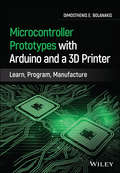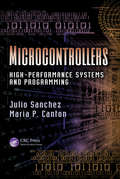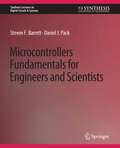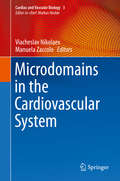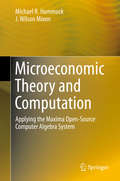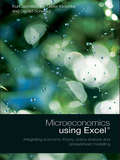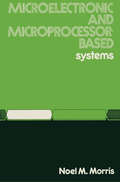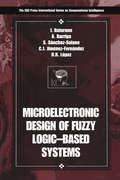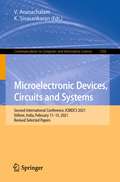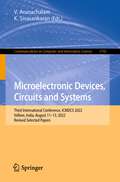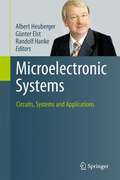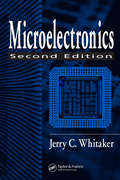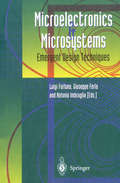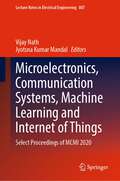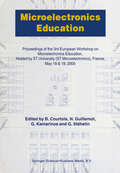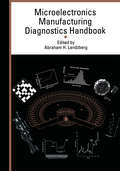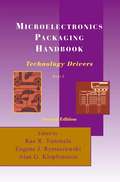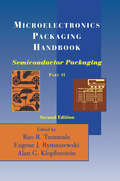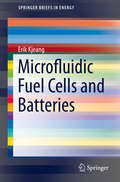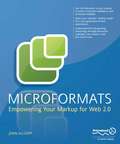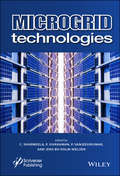- Table View
- List View
Microcontroller Prototypes with Arduino and a 3D Printer: Learn, Program, Manufacture
by Dimosthenis E. BolanakisDiscover a complete treatment of microcomputer programming and application development with Arduino and 3D printers Microcontroller Prototypes with Arduino and a 3D Printer: Learn, Program, Manufacture delivers a comprehensive guide to learning microcontrollers that’s perfectly suited to educators, researchers, and manufacturers. The book provides readers with a seasoned expert’s perspective on the process of microcomputer programming and application development. Carefully designed and written example code and explanatory figures accompany the text, helping the reader fully understand and retain the concepts described within. The book focuses on demonstrating how to craft creative and innovative solutions in embedded systems design by providing practical and illustrative methods and examples. An accompanying website includes functioning and tested source code and learning exercises and the book relies on freeware development tools for the creation of firmware and software code, 3D printed enclosures, and debugging. It allows the reader to work with modern sensors and collect sensor data to a host PC for offline analysis. Readers will also benefit from the inclusion of: A thorough introduction to the art of embedded computers, including their interdisciplinarity, TPACK analysis, and the impact of microcontroller technology on the maker industry An exploration of embedded programming with Arduino, including number representation and special-function codes and C common language reference A discussion of hardware interfaces with the outside world, including digital pin interface, analog pin interface, UART serial interface, I2C, and SPI A treatment of sensors and data acquisition, including environmental measurements with Arduino Uno, orientation and motion detection with Teensy, gesture recognition with TinyZero, and color sensing with Micro:bit A variety of supplementary resources – including source codes and examples - hosted on an accompanying website to be maintained by the author: www.mikroct.com. Perfect for researchers and undergraduate students in electrical and electronic engineering or computer engineering, Microcontroller Prototypes with Arduino and a 3D Printer: Learn, Program, Manufacture will also earn a place in the libraries of hardware engineers, embedded system designers, system engineers, and electronic engineers.
Microcontroller Prototypes with Arduino and a 3D Printer: Learn, Program, Manufacture
by Dimosthenis E. BolanakisDiscover a complete treatment of microcomputer programming and application development with Arduino and 3D printers Microcontroller Prototypes with Arduino and a 3D Printer: Learn, Program, Manufacture delivers a comprehensive guide to learning microcontrollers that’s perfectly suited to educators, researchers, and manufacturers. The book provides readers with a seasoned expert’s perspective on the process of microcomputer programming and application development. Carefully designed and written example code and explanatory figures accompany the text, helping the reader fully understand and retain the concepts described within. The book focuses on demonstrating how to craft creative and innovative solutions in embedded systems design by providing practical and illustrative methods and examples. An accompanying website includes functioning and tested source code and learning exercises and the book relies on freeware development tools for the creation of firmware and software code, 3D printed enclosures, and debugging. It allows the reader to work with modern sensors and collect sensor data to a host PC for offline analysis. Readers will also benefit from the inclusion of: A thorough introduction to the art of embedded computers, including their interdisciplinarity, TPACK analysis, and the impact of microcontroller technology on the maker industry An exploration of embedded programming with Arduino, including number representation and special-function codes and C common language reference A discussion of hardware interfaces with the outside world, including digital pin interface, analog pin interface, UART serial interface, I2C, and SPI A treatment of sensors and data acquisition, including environmental measurements with Arduino Uno, orientation and motion detection with Teensy, gesture recognition with TinyZero, and color sensing with Micro:bit A variety of supplementary resources – including source codes and examples - hosted on an accompanying website to be maintained by the author: www.mikroct.com. Perfect for researchers and undergraduate students in electrical and electronic engineering or computer engineering, Microcontroller Prototypes with Arduino and a 3D Printer: Learn, Program, Manufacture will also earn a place in the libraries of hardware engineers, embedded system designers, system engineers, and electronic engineers.
Microcontrollers: High-Performance Systems and Programming
by Julio Sanchez Maria P. CantonFocusing on the line of high-performance microcontrollers offered by Microchip, Microcontrollers: High-Performance Systems and Programming discusses the practical factors that make the high-performance PIC series a better choice than their mid-range predecessors for most systems. However, one consideration in favor of the mid-range devices is the abundance of published application circuits and code samples. This book fills that gap. Possibility of programming high-performance microcontrollers in a high-level language (C language) Source code compatibility with PIC16 microcontrollers, which facilitates code migration from mid-range to PIC18 devices Pin compatibility of some PIC18 devices with their PIC16 predecessors, making the reuse of PIC16 controllers in circuits originally designed for mid-range hardware possible Designed to be functional and hands-on, this book provides sample circuits with their corresponding programs. It clearly depicts and labels the circuits, in a way that is easy to follow and reuse. Each circuit includes a parts list of the resources and components required for its fabrication. The book matches sample programs to the individual circuits, discusses general programming techniques, and includes appendices with useful information.
Microcontrollers: High-Performance Systems and Programming
by Julio Sanchez Maria P. CantonFocusing on the line of high-performance microcontrollers offered by Microchip, Microcontrollers: High-Performance Systems and Programming discusses the practical factors that make the high-performance PIC series a better choice than their mid-range predecessors for most systems. However, one consideration in favor of the mid-range devices is the abundance of published application circuits and code samples. This book fills that gap. Possibility of programming high-performance microcontrollers in a high-level language (C language) Source code compatibility with PIC16 microcontrollers, which facilitates code migration from mid-range to PIC18 devices Pin compatibility of some PIC18 devices with their PIC16 predecessors, making the reuse of PIC16 controllers in circuits originally designed for mid-range hardware possible Designed to be functional and hands-on, this book provides sample circuits with their corresponding programs. It clearly depicts and labels the circuits, in a way that is easy to follow and reuse. Each circuit includes a parts list of the resources and components required for its fabrication. The book matches sample programs to the individual circuits, discusses general programming techniques, and includes appendices with useful information.
Microcontrollers Fundamentals for Engineers and Scientists (Synthesis Lectures on Digital Circuits & Systems)
by Steven F. Barrett Daniel J. PackThis book provides practicing scientists and engineers a tutorial on the fundamental concepts and use of microcontrollers. Today, microcontrollers, or single integrated circuit (chip) computers, play critical roles in almost all instrumentation and control systems. Most existing books arewritten for undergraduate and graduate students taking an electrical and/or computer engineering course. Furthermore, these texts have beenwritten with a particular model of microcontroller as the target discussion. These textbooks also require a requisite knowledge of digital design fundamentals. This textbook presents the fundamental concepts common to all microcontrollers. Our goals are to present the over–arching theory of microcontroller operation and to provide a detailed discussion on constituent subsystems available in most microcontrollers. With such goals, we envision that the theory discussed in this book can be readily applied to a wide variety of microcontroller technologies, allowing practicing scientists and engineers to become acquainted with basic concepts prior to beginning a design involving a specific microcontroller. We have found that the fundamental principles of a given microcontroller are easily transferred to other controllers. Although this is a relatively small book, it is packed with useful information for quickly coming up to speed on microcontroller concepts.
Microdomains in the Cardiovascular System (Cardiac and Vascular Biology #4)
by Manuela Zaccolo Viacheslav NikolaevThe book comprehensively presents new findings in cardiovascular research related to signaling microdomains in health and disease. Important second messengers such as cAMP, cGMP, calcium and their role in microdomain signaling are discussed. The book offers and explains methodical approaches and technical ways how to successfully analyze microdomain signaling, also in the context of disease. It further provides scientific perspectives and strategies that are based on the concept of signaling within microdomains and that can revolutionize pharmacology and eventually lead to the effective treatment of cardiovascular diseases in future.This book is written for scientists in cardiovascular research, pharmacology, molecular and cellular biology as well as medical doctors in cardiology, angiology and nephrology.
Microeconomic Theory and Computation: Applying the Maxima Open-Source Computer Algebra System
by Michael R. Hammock J. Wilson MixonEconomists can use computer algebra systems to manipulate symbolic models, derive numerical computations, and analyze empirical relationships among variables. Maxima is an open-source multi-platform computer algebra system that rivals proprietary software. Maxima’s symbolic and computational capabilities enable economists and financial analysts to develop a deeper understanding of models by allowing them to explore the implications of differences in parameter values, providing numerical solutions to problems that would be otherwise intractable, and by providing graphical representations that can guide analysis. This book provides a step-by-step tutorial for using this program to examine the economic relationships that form the core of microeconomics in a way that complements traditional modeling techniques. Readers learn how to phrase the relevant analysis and how symbolic expressions, numerical computations, and graphical representations can be used to learn from microeconomic models. In particular, comparative statics analysis is facilitated. Little has been published on Maxima and its applications in economics and finance, and this volume will appeal to advanced undergraduates, graduate-level students studying microeconomics, academic researchers in economics and finance, economists, and financial analysts.
Microeconomics using Excel: Integrating Economic Theory, Policy Analysis and Spreadsheet Modelling
by Gerald Schwarz Kurt Jechlitschka Dieter KirschkeUsing Microsoft Excel, the market leading spreadsheet package, this book combines theory with modelling aspects and spreadsheet analysis. Microeconomics Using Excel provides students with the tools with which to better understand microeconomic analysis. It focuses on solving microeconomic problems by integrating economic theory, policy analysis and spreadsheet modelling. This unique approach facilitates a more comprehensive understanding of the link between theory and problem solving. It is divided into four core parts: analysis of price policies analysis of structural policies multi-market models budget policy and priority settings. The theory behind each problem is explained and each model is solved using excel. Each model is also available online and can be used as a prototype for analysis and specific needs. Microeconomics using Excel will be of great interest to students studying economics as well as to professionals in economic and policy analysis.
Microeconomics using Excel: Integrating Economic Theory, Policy Analysis and Spreadsheet Modelling
by Gerald Schwarz Kurt Jechlitschka Dieter KirschkeUsing Microsoft Excel, the market leading spreadsheet package, this book combines theory with modelling aspects and spreadsheet analysis. Microeconomics Using Excel provides students with the tools with which to better understand microeconomic analysis.It focuses on solving microeconomic problems by integrating economic theory, policy analysis and
Microelectronic Design of Fuzzy Logic-Based Systems (International Series on Computational Intelligence)
by Iluminada Baturone Angel Barriga Carlos Jimenez-Fernandez Diego R. Lopez Santiago Sanchez-SolanoFuzzy logic has virtually exploded over the landscape of emerging technologies, becoming an integral part of myriad applications and a standard tool for engineers. Until recently, most of the attention and applications have centered on fuzzy systems implemented in software. But these systems are limited. Problems that require real-time operation, low area, or low power consumption demand hardware designed to the fuzzy paradigm - and engineers with the background and skills to design it.Microelectronic Design of Fuzzy Logic-Based Systems offers low-cost answers to issues that software cannot resolve. From the theoretical, architectural, and technological foundation to design tools and applications, it serves as your guide to effective hardware realizations of fuzzy logic.Review fuzzy logic theory and the basic issues of fuzzy sets, operators, and inference mechanismsExplore the trade-offs between efficient theoretical behavior and practical hardware realizationsDiscover the properties of the possible microelectronic realizations of fuzzy systems - conventional processors, fuzzy coprocessors, and fuzzy chipsInvestigate the design of fuzzy chips that implement the whole fuzzy inference method into silicon Analyze analog, digital, and mixed-signal techniquesReduce your design effort for fuzzy systems with CAD tools - learn the requirements they should meet and survey current environments.Put it all together - see examples and case studies illustrating how all of this is used to solve particular problems related to control and neuro-fuzzy applications
Microelectronic Devices, Circuits and Systems: Second International Conference, ICMDCS 2021, Vellore, India, February 11-13, 2021, Revised Selected Papers (Communications in Computer and Information Science #1392)
by V. Arunachalam K. SivasankaranThis book constitutes selected papers from the Second International Conference on Microelectronic Devices, Circuits and Systems, ICMDCS 2021, held in Vellore, India, in February 2021. The 32 full papers and 6 short papers presented were thoroughly reviewed and selected from 103 submissions. They are organized in the topical sections on digital design for signal, image and video processing; VLSI testing and verification; emerging technologies and IoT; nano-scale modelling and process technology device; analog and mixed signal design; communication technologies and circuits; technology and modelling for micro electronic devices; electronics for green technology.
Microelectronic Devices, Circuits and Systems: Third International Conference, ICMDCS 2022, Vellore, India, August 11–13, 2022, Revised Selected Papers (Communications in Computer and Information Science #1743)
by V. Arunachalam K. SivasankaranThis book constitutes the proceedings of the Third International Conference on Microelectronic Devices, Circuits and Systems, ICMDCS 2022, was held in Vellore, India, in August 2022.The 9 full papers and 5 short paper presented in this volume were carefully reviewed and selected from 84 submissions. The papers are organized in the following topical sections: System Level Design; Digital Design; Analog, Mixed-Signal and RF Design; and Emerging Technologies.
Microelectronic Systems: Circuits, Systems and Applications
by Karlheinz Kirsch Janina HeppnerThis book is dedicated to Prof. Dr. Heinz Gerhäuser on the occasion of his retirement both from the position of Executive Director of the Fraunhofer Institute for Integrated Circuits IIS and from the Endowed Chair of Information Technologies with a Focus on Communication Electronics (LIKE) at the Friedrich-Alexander-Universität Erlangen-Nürnberg.Heinz Gerhäuser's vision and entrepreneurial spirit have made the Fraunhofer IIS one of the most successful and renowned German research institutions. He has been Director of the Fraunhofer IIS since 1993, and under his leadership it has grown to become the largest of Germany's 60 Fraunhofer Institutes, a position it retains to this day, currently employing over 730 staff. Likely his most important scientific as well as application-related contribution was his pivotal role in the development of the mp3 format, which would later become a worldwide success.The contributions to this Festschrift were written by both Fraunhofer IIS staff and external project team members in appreciation of Prof. Dr. Gerhäuser's lifetime academic achievements and his inspiring leadership at the Fraunhofer IIS. The papers reflect the broad spectrum of the institute's research activities and are grouped into sections on circuits, information systems, visual computing, and audio and multimedia. They provide academic and industrial researchers in fields like signal processing, sensor networks, microelectronics, and integrated circuits with an up-to-date overview of research results that have a huge potential for cutting-edge industrial applications.
Microelectronics (Electronics Handbook Series)
by Jerry C. WhitakerWhen it comes to electronics, demand grows as technology shrinks. From consumer and industrial markets to military and aerospace applications, the call is for more functionality in smaller and smaller devices. Culled from the second edition of the best-selling Electronics Handbook, Microelectronics, Second Edition presents a summary of the current state of microelectronics and its innovative directions.This book focuses on the materials, devices, and applications of microelectronics technology. It details the IC design process and VLSI circuits, including gate arrays, programmable logic devices and arrays, parasitic capacitance, and transmission line delays. Coverage ranges from thermal properties and semiconductor materials to MOSFETs, digital logic families, memory devices, microprocessors, digital-to-analog and analog-to-digital converters, digital filters, and multichip module technology. Expert contributors discuss applications in machine vision, ad hoc networks, printing technologies, and data and optical storage systems. The book also includes defining terms, references, and suggestions for further reading. This edition features two new sections on fundamental properties and semiconductor devices.With updated material and references in every chapter, Microelectronics, Second Edition is an essential reference for work with microelectronics, electronics, circuits, systems, semiconductors, logic design, and microprocessors.
Microelectronics (Electronics Handbook Series)
by Jerry C. WhitakerWhen it comes to electronics, demand grows as technology shrinks. From consumer and industrial markets to military and aerospace applications, the call is for more functionality in smaller and smaller devices. Culled from the second edition of the best-selling Electronics Handbook, Microelectronics, Second Edition presents a summary of the current state of microelectronics and its innovative directions.This book focuses on the materials, devices, and applications of microelectronics technology. It details the IC design process and VLSI circuits, including gate arrays, programmable logic devices and arrays, parasitic capacitance, and transmission line delays. Coverage ranges from thermal properties and semiconductor materials to MOSFETs, digital logic families, memory devices, microprocessors, digital-to-analog and analog-to-digital converters, digital filters, and multichip module technology. Expert contributors discuss applications in machine vision, ad hoc networks, printing technologies, and data and optical storage systems. The book also includes defining terms, references, and suggestions for further reading. This edition features two new sections on fundamental properties and semiconductor devices.With updated material and references in every chapter, Microelectronics, Second Edition is an essential reference for work with microelectronics, electronics, circuits, systems, semiconductors, logic design, and microprocessors.
Microelectronics and Microsystems: Emergent Design Techniques
by Luigi Fortuna Giuseppe Ferla Antonio ImbrugliaThe book presents the best contributions, extracted from the theses written by the students who have attended the second edition of the Master in Microelectronics and Systems that has been organized by the Universita degli Studi di Catania and that has been held at the STMicroelectronics Company (Catania Site) from May 2000 to January 2001. In particular, the mentioned Master has been organized among the various ac tivities of the "Istituto Superiore di Catania per la Formazione di Eccellenza". The Institute is one of the Italian network of universities selected by MURST (Ministry University Research Scientific Technology). The first aim of tl;te Master in Microelectronics and Systems is to increase the skills of the students with the Laurea Degree in Physics or Electrical Engineering in the more advanced areas as VLSI system design, high-speed low-voltage low-power circuitS and RF systems. The second aim has been to involve in the educational program companies like STMicroelectronics, ACCENT and ITEL, interested in emergent microelectronics topics, to cooperate with the University in developing high-level research projects. Besides the tutorial activity during the teaching hours, provided by national and international researchers, a significant part of the School has been dedicated to the presentation of specific CAD tools and experiments in order to prepare the students to solve specific problems during the stage period and in the thesis work.
Microelectronics, Communication Systems, Machine Learning and Internet of Things: Select Proceedings of MCMI 2020 (Lecture Notes in Electrical Engineering #887)
by Vijay Nath Jyotsna Kumar MandalThis volume presents peer-reviewed papers of the First International Conference on Microelectronics, Communication Systems, Machine Learning, and the Internet of Things (MCMI-2020). This book discusses recent trends in technology and advancement in microelectronics, nano-electronics, VLSI design, IC technologies, wireless communications, optical communications, SoC, advanced instrumentations, signal processing, internet of things, machine learning, image processing, green energy, hybrid vehicles, weather forecasting, cloud computing, renewable energy, CMOS sensors, actuators, RFID, transducers, real-time embedded system, sensor network and applications, EDA design tools and techniques, fuzzy logic & artificial intelligence, high-performance computer architecture, AI-based robotics & applications, brain-computer interface, deep learning, advanced operating systems, supply chain development & monitoring, physical systems design, ICT applications, e-farming, information security, etc. It includes original papers based on theoretical, practical, experimental, simulations, development, application, measurement, and testing. The applications and solutions discussed in the book will serve as good reference material for young scholars, researchers, and academics.
Microelectronics Education: Proceedings of the 3rd European Workshop on Microelectronics Education
by B. Courtois N. Guillemot G. Kamarinos G. StéhelinThis is the third edition of the European Workshop on Microelectronics Education (EWME). A steady-state regime has now been reached. An international community of university teachers is constituted; they exchange their experience and their pedagogical tools. They discuss the best ways to transfer the rapidly changing techniques to their students, and to introduce them to the new physical and mathematical concepts and models for the innovative techniques, devices, circuits and design methods. The number of abstracts submitted to EWME 2000 (about one hundred) enabled the scientific committee to proceed to a clear selection. EWME is a European meeting. Indeed, authors from 20 different European countries contribute to this volume. Nevertheless, the participation of authors from Brazil, Canada, China, New Zealand, and USA, shows that the workshop gradually attains an international dimension. th The 20 century can be characterized as the "century of electron". The electron, as an elementary particle, was discovered by J.J. Thomson in 1897, and was rapidly used to transfer energy and information. Thanks to electron, universe and micro-cosmos could be explored. Electron became the omnipotent and omnipresent, almost immaterial, angel of our W orId. This was made possible thanks to electronics and, for the last 30 years, to microelectronics. Microelectronics not only modified and even radically transformed the industrial and the every-day landscapes, but it also led to the so-called "information revolution" with which begins the 21 st century.
Microelectronics Manufacturing Diagnostics Handbook
by Abraham LandzbergThe world of microelectronics is filled with cusses measurement systems, manufacturing many success stories. From the use of semi control techniques, test, diagnostics, and fail ure analysis. It discusses methods for modeling conductors for powerful desktop computers to their use in maintaining optimum engine per and reducing defects, and for preventing de formance in modem automobiles, they have fects in the first place. The approach described, clearly improved our daily lives. The broad while geared to the microelectronics world, has useability of the technology is enabled, how applicability to any manufacturing process of similar complexity. The authors comprise some ever, only by the progress made in reducing their cost and improving their reliability. De of the best scientific minds in the world, and fect reduction receives a significant focus in our are practitioners of the art. The information modem manufacturing world, and high-quality captured here is world class. I know you will diagnostics is the key step in that process. find the material to be an excellent reference in of product failures enables step func Analysis your application. tion improvements in yield and reliability. which works to reduce cost and open up new Dr. Paul R. Low applications and technologies. IBM Vice President and This book describes the process ofdefect re of Technology Products General Manager duction in the microelectronics world.
Microelectronics Packaging Handbook: Technology Drivers Part I
by R.R. Tummala Eugene J. Rymaszewski Alan G. KlopfensteinElectronics has become the largest industry, surpassing agriCUlture, auto. and heavy metal industries. It has become the industry of choice for a country to prosper, already having given rise to the phenomenal prosperity of Japan. Korea. Singapore. Hong Kong. and Ireland among others. At the current growth rate, total worldwide semiconductor sales will reach $300B by the year 2000. The key electronic technologies responsible for the growth of the industry include semiconductors. the packaging of semiconductors for systems use in auto, telecom, computer, consumer, aerospace, and medical industries. displays. magnetic, and optical storage as well as software and system technologies. There has been a paradigm shift, however, in these technologies. from mainframe and supercomputer applications at any cost. to consumer applications at approximately one-tenth the cost and size. Personal computers are a good example. going from $500IMIP when products were first introduced in 1981, to a projected $lIMIP within 10 years. Thin. light portable. user friendly and very low-cost are. therefore. the attributes of tomorrow's computing and communications systems. Electronic packaging is defined as interconnection. powering, cool ing, and protecting semiconductor chips for reliable systems. It is a key enabling technology achieving the requirements for reducing the size and cost at the system and product level.
Microelectronics Packaging Handbook: Semiconductor Packaging
by R.R. Tummala Eugene J. Rymaszewski Alan G. KlopfensteinElectronics has become the largest industry, surpassing agriculture, auto, and heavy metal industries. It has become the industry of choice for a country to prosper, already having given rise to the phenomenal prosperity of Japan, Korea, Singapore, Hong Kong, and Ireland among others. At the current growth rate, total worldwide semiconductor sales will reach $300B by the year 2000. The key electronic technologies responsible for the growth of the industry include semiconductors, the packaging of semiconductors for systems use in auto, telecom, computer, consumer, aerospace, and medical industries, displays, magnetic, and optical storage as well as software and system technologies. There has been a paradigm shift, however, in these technologies, from mainframe and supercomputer applications at any cost, to consumer applications at approximately one-tenth the cost and size. Personal computers are a good example, going from $500IMIP when products were first introduced in 1981, to a projected $IIMIP within 10 years. Thin, light portable, user friendly and very low-cost are, therefore, the attributes of tomorrow's computing and communications systems. Electronic packaging is defined as interconnection, powering, cool ing, and protecting semiconductor chips for reliable systems. It is a key enabling technology achieving the requirements for reducing the size and cost at the system and product level.
Microfluidic Fuel Cells and Batteries (SpringerBriefs in Energy)
by Erik KjeangMicrofluidic fuel cells and batteries represent a special type of electrochemical power generators that can be miniaturized and integrated in a microfluidic chip. Summarizing the initial ten years of research and development in this emerging field, this SpringerBrief is the first book dedicated to microfluidic fuel cell and battery technology for electrochemical energy conversion and storage. Written at a critical juncture, where strategically applied research is urgently required to seize impending technology opportunities for commercial, analytical, and educational utility, the intention is for this book to be a ‘one-stop shop’ for current and prospective researchers in the general area of membraneless, microfluidic electrochemical energy conversion. As the overall goal of the book is to provide a comprehensive resource for both research and technology development, it features extensive descriptions of the underlying fundamental theory, fabrication methods, and cell design principles, as well as a thorough review of previous contributions in this field and a future outlook with recommendations for further work. It is hoped that the content will entice and enable new research groups and engineers to rapidly gain traction in their own laboratories towards the development of next generation microfluidic electrochemical cells.
Microformats: Empowering Your Markup for Web 2.0
by John AllsoppIn this book, noted web developer and long time WaSP member John Allsop offers practical examples to teach all you need to know about Microformats. Coverage details what Microformats are currently available and how to use them; the general principles of how they work; how to use Microformats with web sites and software that already support them; and how to create your own. The end of the book features a chapter full of anecdotes from many professional web designers and developers already using Microformats in their work today--what worked, what didn't, things to watch for--so you can learn from their experiences.
Microgrid Technologies
by C. Sharmeela P. Sivaraman P. Sanjeevikumar Jens Bo Holm-NielsenMicrogrid technology is an emerging area, and it has numerous advantages over the conventional power grid. A microgrid is defined as Distributed Energy Resources (DER) and interconnected loads with clearly defined electrical boundaries that act as a single controllable entity concerning the grid. Microgrid technology enables the connection and disconnection of the system from the grid. That is, the microgrid can operate both in grid-connected and islanded modes of operation. Microgrid technologies are an important part of the evolving landscape of energy and power systems. Many aspects of microgrids are discussed in this volume, including, in the early chapters of the book, the various types of energy storage systems, power and energy management for microgrids, power electronics interface for AC & DC microgrids, battery management systems for microgrid applications, power system analysis for microgrids, and many others. The middle section of the book presents the power quality problems in microgrid systems and its mitigations, gives an overview of various power quality problems and its solutions, describes the PSO algorithm based UPQC controller for power quality enhancement, describes the power quality enhancement and grid support through a solar energy conversion system, presents the fuzzy logic-based power quality assessments, and covers various power quality indices. The final chapters in the book present the recent advancements in the microgrids, applications of Internet of Things (IoT) for microgrids, the application of artificial intelligent techniques, modeling of green energy smart meter for microgrids, communication networks for microgrids, and other aspects of microgrid technologies. Valuable as a learning tool for beginners in this area as well as a daily reference for engineers and scientists working in the area of microgrids, this is a must-have for any library.
